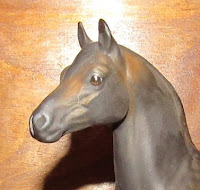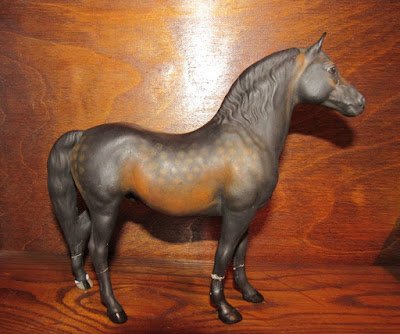Everyone has different taste in model horses. "I only collect mint condition model horses," some people tell me. "If it's not perfect, I don't even want to look at it."
And that's okay. I like mint condition model horses, too. My own collection contains a few undamaged model horses. A couple of those have always lived in well-padded boxes in the closet because they'd be hard to replace.
Mostly, though, the members of my herd look like survivors of a war zone, with their scuffs and scrapes, their missing ears and tail tips, their reglued legs. Since I gave up participating in live model horse shows decades ago, it doesn't matter to me if they've been professionally restored. I keep them because I still just like them, damage and all.
January 17 is the anniversary of the 1994 Northridge Earthquake -- a good time to remember and reflect on just how fragile the items in our hobby can be.
Because there's nothing like a natural disaster to remind us that, much as we enjoy our model horses, wonderful as they are, old friends and treasured possessions they may be --
 |
| Several dozen, mostly ceramic, model horse figurines, a few seconds after the 1994 Northridge Earthquake. |
I hope you never wake up to a scene like this, or have to run away from your home and your hobby because of fire or flood. And I hope no one ever chides you for "not taking better care of your horse figurines" after a natural disaster strikes. If the natural disaster is big enough to take down a wall of your house, no amount of Quake-Hold or museum wax is going to protect your model horse collection.
For many collectors, especially those who own several valuable pieces, having a separate insurance policy on your model horses might be worth considering.
If you have more than a few model horses, it's also worth your time to create a written list or spreadsheet of what you own, so it will be easier to deal with when the time comes for your model horses to pass into other collectors' hands.
 |
| The model horse jigsaw puzzles in the aftermath of the magnitude 6.8 earthquake. The force of the 'quake pulverized some of the ceramic horses' legs. Some of them ended up with other collectors who have the skills to rebuild tiny ceramic horse legs and ears and tails. |
I also hope that, if you ever do lose a valuable and/or sentimental favorite member of your model horse herd, you'll be able to get to the point where you can come to terms with that loss. And I hope that, once you get to the point when you can start to rebuild your collection, your friends will give (not just sell) you some wonderful pieces from their own model horse herds.
The most-damaged survivor in my little herd is a venerable, and otherwise drop-dead gorgeous, Monrovia-era Hagen-Renaker large "Amir." He was a victim not of a major natural disaster, but an everyday household accident when his previous owner had him. She had set him "just for a minute" on a windowsill, when a gust of wind blew against the curtains. The curtains popped the "Amir" into the air and he fell to the floor in an instant. His previous owner painstakingly glued him back together -- a small miracle, of sorts.
He still looks sort of okay from a distance.
In reality, though, he had broken apart into more than 20 pieces. And up close you can see every one of them.
"Amir" still has fault lines all over his face and body. I can't even imagine asking a professional restorer to unglue him and make him look "mint" again.
Not just because of the cost. It's because I like him just the way he is. Repairs and all.
He won't last forever, but in the meantime "Amir" reminds me that I need to be resilient, too. When that 6.8 magnitude earthquake happened -- a couple of decades after he suffered all that damage from his mishap on a windowsill -- the only damage he sustained was one re-broken leg. I glued it back on, and he's been standing (yes, with museum wax under his hooves) on my shelves ever since.
Earlier this year a good friend went to an estate sale and found a second Hagen-Renaker large "Amir" for me, in excellent condition.
I just like him, too. Not just because he's in good condition, but because my friend went out of her way to obtain him for me.
Cherish your model horses. Repair or restore them, or let them go to someone else graciously, when they are damaged. And remember what Nazi concentration camp survivor Corrie ten Boom was quoted as saying:









